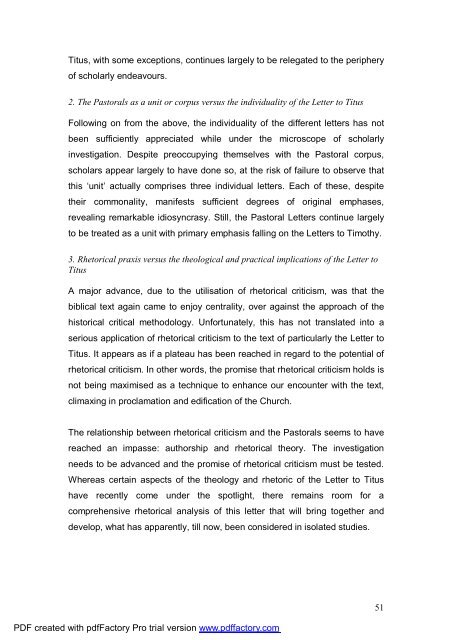A Text centred rhetorical analysis of Paul's Letter to Titus
A Text centred rhetorical analysis of Paul's Letter to Titus
A Text centred rhetorical analysis of Paul's Letter to Titus
You also want an ePaper? Increase the reach of your titles
YUMPU automatically turns print PDFs into web optimized ePapers that Google loves.
<strong>Titus</strong>, with some exceptions, continues largely <strong>to</strong> be relegated <strong>to</strong> the periphery<br />
<strong>of</strong> scholarly endeavours.<br />
2. The Pas<strong>to</strong>rals as a unit or corpus versus the individuality <strong>of</strong> the <strong>Letter</strong> <strong>to</strong> <strong>Titus</strong><br />
Following on from the above, the individuality <strong>of</strong> the different letters has not<br />
been sufficiently appreciated while under the microscope <strong>of</strong> scholarly<br />
investigation. Despite preoccupying themselves with the Pas<strong>to</strong>ral corpus,<br />
scholars appear largely <strong>to</strong> have done so, at the risk <strong>of</strong> failure <strong>to</strong> observe that<br />
this ‘unit’ actually comprises three individual letters. Each <strong>of</strong> these, despite<br />
their commonality, manifests sufficient degrees <strong>of</strong> original emphases,<br />
revealing remarkable idiosyncrasy. Still, the Pas<strong>to</strong>ral <strong>Letter</strong>s continue largely<br />
<strong>to</strong> be treated as a unit with primary emphasis falling on the <strong>Letter</strong>s <strong>to</strong> Timothy.<br />
3. Rhe<strong>to</strong>rical praxis versus the theological and practical implications <strong>of</strong> the <strong>Letter</strong> <strong>to</strong><br />
<strong>Titus</strong><br />
A major advance, due <strong>to</strong> the utilisation <strong>of</strong> <strong>rhe<strong>to</strong>rical</strong> criticism, was that the<br />
biblical text again came <strong>to</strong> enjoy centrality, over against the approach <strong>of</strong> the<br />
his<strong>to</strong>rical critical methodology. Unfortunately, this has not translated in<strong>to</strong> a<br />
serious application <strong>of</strong> <strong>rhe<strong>to</strong>rical</strong> criticism <strong>to</strong> the text <strong>of</strong> particularly the <strong>Letter</strong> <strong>to</strong><br />
<strong>Titus</strong>. It appears as if a plateau has been reached in regard <strong>to</strong> the potential <strong>of</strong><br />
<strong>rhe<strong>to</strong>rical</strong> criticism. In other words, the promise that <strong>rhe<strong>to</strong>rical</strong> criticism holds is<br />
not being maximised as a technique <strong>to</strong> enhance our encounter with the text,<br />
climaxing in proclamation and edification <strong>of</strong> the Church.<br />
The relationship between <strong>rhe<strong>to</strong>rical</strong> criticism and the Pas<strong>to</strong>rals seems <strong>to</strong> have<br />
reached an impasse: authorship and <strong>rhe<strong>to</strong>rical</strong> theory. The investigation<br />
needs <strong>to</strong> be advanced and the promise <strong>of</strong> <strong>rhe<strong>to</strong>rical</strong> criticism must be tested.<br />
Whereas certain aspects <strong>of</strong> the theology and rhe<strong>to</strong>ric <strong>of</strong> the <strong>Letter</strong> <strong>to</strong> <strong>Titus</strong><br />
have recently come under the spotlight, there remains room for a<br />
comprehensive <strong>rhe<strong>to</strong>rical</strong> <strong>analysis</strong> <strong>of</strong> this letter that will bring <strong>to</strong>gether and<br />
develop, what has apparently, till now, been considered in isolated studies.<br />
PDF created with pdfFac<strong>to</strong>ry Pro trial version www.pdffac<strong>to</strong>ry.com<br />
51

















